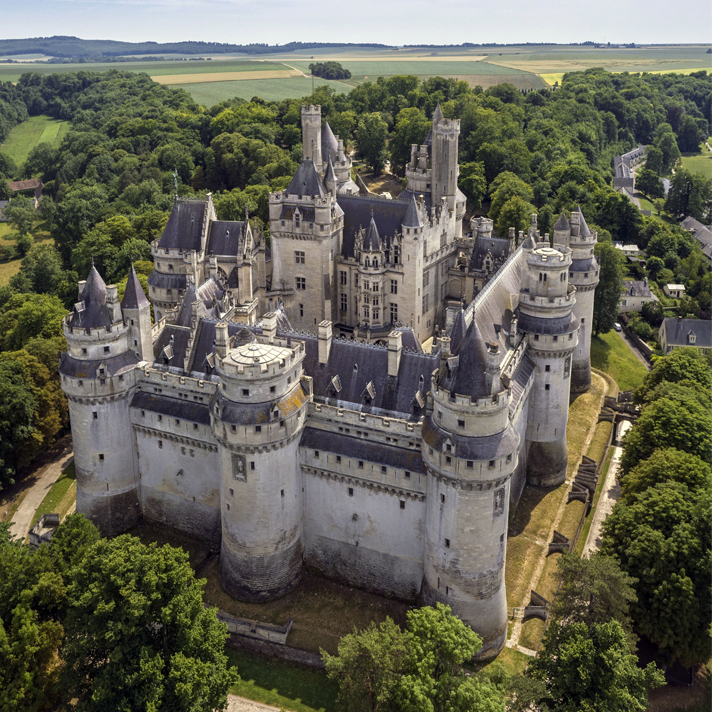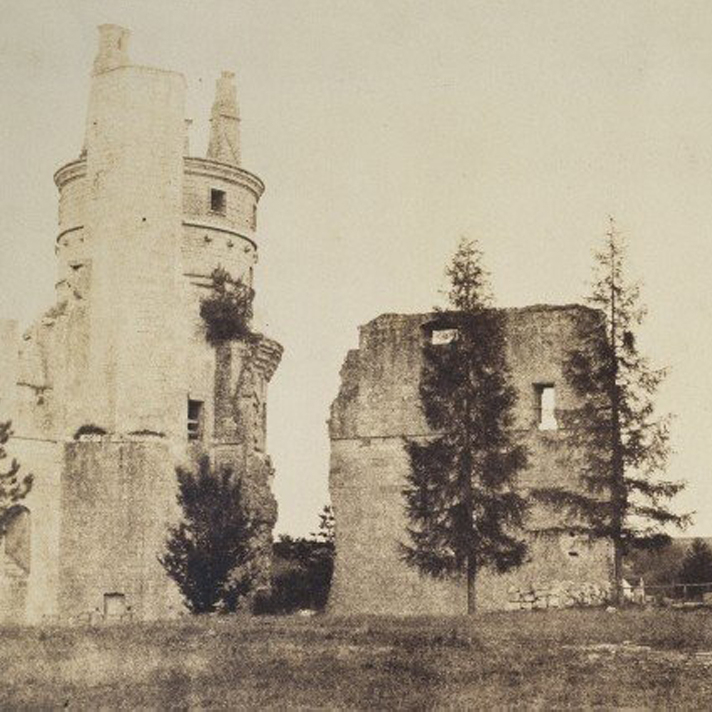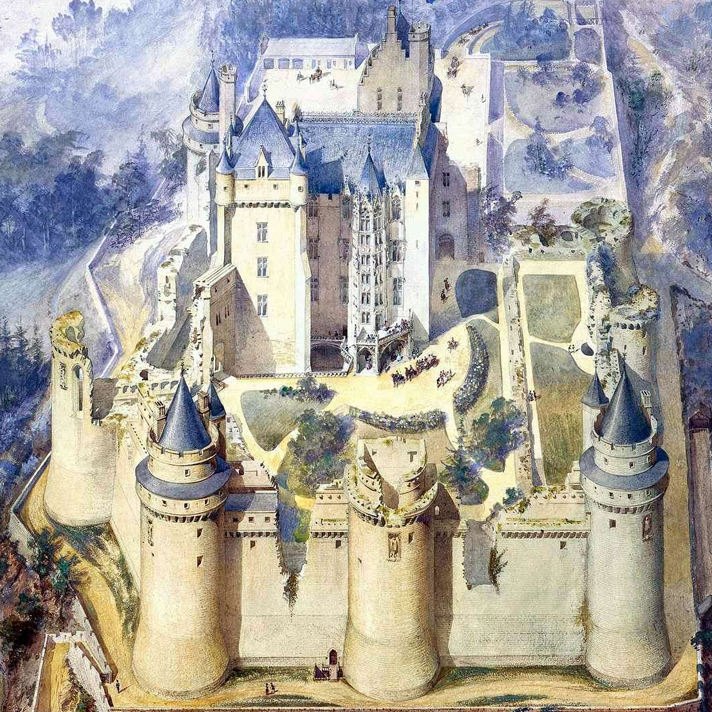History
article | Reading time10 min
History
article | Reading time10 min
Near Compiègne, discover the fortified castle of Pierrefonds, dismantled in the 17th century and reinvented in the 19th century by the architect Viollet-le-Duc in an extraordinary reinterpretation of the Middle Ages and the Renaissance. A treasure of architecture awaits you: the chapel, the court of honor or the cellars will leave you speechless.
The castle of Pierrefonds is born in 1397: it is built in less than 10 years under the impulse of Louis d' Orleans, son of the king Charles V and younger brother of the king Charles VI. He received these Valois lands as an apanage and made this county a strong strategic place to defend the city of Paris from Burgundian and English invasions (numerous during the Hundred Years War).
If Louis d'Orléans was able to build the castle of Pierrefonds and all its strongholds such as the castle of Coucy or the castle of La Ferté-Milon for example, it is thanks to the dowry brought by his wife, Valentine Visoncti, at the time of their union.
The castle of Pierrefonds is one of the most successful testimonies of the military architecture of the end of the Middle Ages.
© Scotome-CMN
After the death of Louis of Orleans, assassinated in Paris on November 23, 1407 by his cousin John the Fearless, Valentine Visconti settled in his castle of Blois and never returned to the county of Valois. The castle will remain attached to the crown until the reign of Louis XIII, passing from hand to hand to the league princes like the famous Antoine d'Estrées, father of Gabrielle d'Estrées, mistress of Henri IV.
To weaken the strongholds belonging to the princes opposing the king, Louis XIII had several fortresses dismantled in the kingdom, including the castle of Pierrefonds. In 1617, he entrusted Richelieu with the task of besieging and destroying the emblematic medieval castle with cannonballs.
The castle fell into oblivion, a stone quarry invaded by ivy, and became the ideal place for walkers. It is then qualified of " romantic ruins "...
© Médiathèque de l'architecture et du patrimoine
It is in the XIXth century that the castle is reborn. Since the siege of Richelieu, the first key date is its classification as Historical Monument in 1848.
Following this classification, it was not until 1857 and the decision of a man who would change the destiny of the castle: Napoleon III.
You know now the origins of the medieval castle, we will tell you its rebirth!
© Pierre Coudert / Centre des monuments nationaux
In 1855, the emperor Napoleon III, impassioned by the new industrial and modern technologies, is the instigator of the universal exhibition of Paris .
Thanks to the success of this exhibition which attracts more than 5 million visitors, the emperor asserts his power by making the castle of Pierrefonds, from 1857, a stake of the radiation of France, but also of its industrial and artistic know-how.
Napoleon III decides to transform the romantic ruins of Pierrefonds into an Imperial residence. He took the advice of Prosper Mérimée and entrusted Eugène Viollet-le-Duc with the restoration of the fortress of Louis d'Orléans to make it a symbol of the Second Empire.
The restoration work was spread over thirty years.
In front of the multitude of building sites carried out in France and in Europe, Eugène Viollet-Le-Duc appoints Lucyan Wyganowski as chief person in charge of the work of the castle of Pierrefonds. During the restoration, this man of confidence, true right-hand man, carries out of a hand of master this masterpiece of the architect.
© Base regards / Centre des monuments nationaux
Emblematic room of the castle of Pierrefonds, the room of the Preuses, by its dimensions and its decoration, is without any doubt the flagship room of the monument. Its vault in the shape of an overturned ship's hull, its 53 meters long, 12 meters high and 10 meters wide give it the appearance of a ballroom.
© Colombe Clier - CMN
By presenting his cabinet of weapons and armors in a castle of legend, Napoleon III adheres fully to the tastes of his time.
He did not reconstruct the arms room of a castle but rather recreated the atmosphere and environment of a medieval residence by installing his collection there.
The emperor, whose interest in technical progress, particularly in artillery, is well known, showed a keen interest in ancient weapons.
In this field, his various acquisitions attest to his very sound choices. According to Viollet-le-Duc, the emperor wished to make Pierrefonds a museum of the Middle Ages comparable to the Gallo-Roman museum of Saint-Germain-en-Laye.
© Médiathèque de l'architecture et du patrimoine
With the fall of the Second Empire, in 1870, the restoration work is stopped. The castle has already its definitive silhouette but the interior decorations are far from being completed.
The imperial family left France for England: they never took advantage of the monument and the sumptuous parties that could have been organized there.
The castle, entirely financed by the emperor and the civil list, became the property of the State. The following works will only be maintenance and repairs.
This reinterpretation of the Middle Ages is not limited to the exterior of the castle, but also concerns its rooms with painted and carved woodwork decorations:
© Philippe Berthé / Centre des monuments nationaux
The castle of Pierrefonds plays an essential role during the First World War since it is used as barracks as of the autumn 1914 and this until the Armistice.
We are only about fifteen kilometers from the front and the village of Pierrefonds becomes a strategic military support center. It welcomed soldiers in cantonment, hospitals and ambulances. The castle received up to 1500 soldiers per night, while the priory, the thermal baths, the train station and the village schools saw an influx of wounded.
The soldiers then took the time to walk around the village, to go to Palesne to drink a "chopine", or to rediscover the joys of painting and music.
The photos of archives also testify of the craft industry, of this "art of the trenches", which makes it possible to pass the time like the races of totos (of lice) organized in the room of Preuses.
© Association Soissonnaise 14-18
The graffiti of the castle of Pierrefonds are the beautiful heritage left by these soldiers. They reveal their way of life, their mood but also their humor!
You can discover them during the thematic conference visits.
Today managed by the Center of the national monuments, the castle of Pierrefonds opens its doors all the year to you.
© Association Soissonnaise 14-18
Did you know that the castle is also a set of choice for film producers? If you open your eyes, you will certainly find it in the series Merlin, Les Visiteurs 2 or in Jeanne d'Arc of Luc Besson.
© Shine limited










